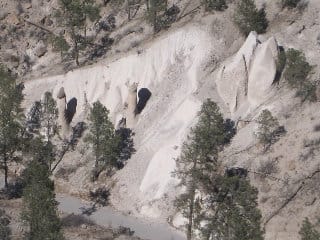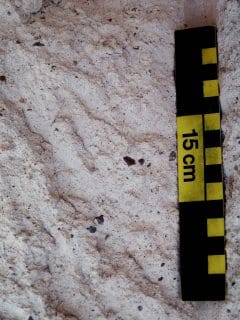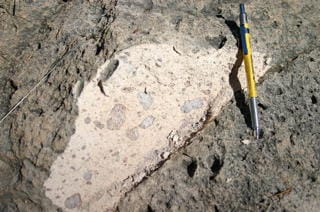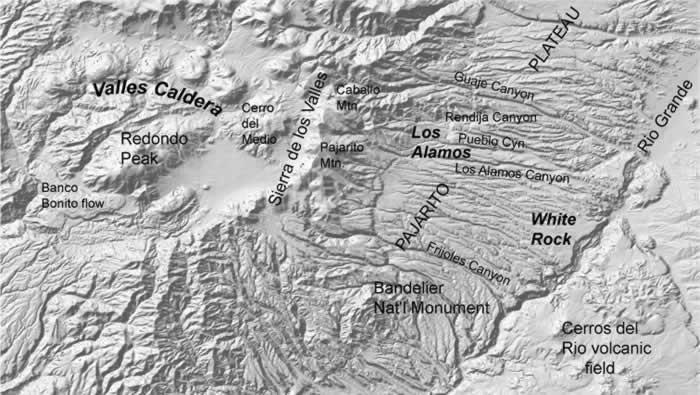This guide displays two informative images of our area, and details about 10 of our major rock formations. The selector box below will find rock formations by name.
Most of the rocks that make up the Pajarito Plateau are volcanic rocks, which are the products of volcanic eruption. The volcanic rocks lie on top of sedimentary rocks, rocks that are eroded from older pre-existing rocks, transported by water, wind, or ice, and then deposited. The sedimentary rocks are important aquifers for the communities of Los Alamos and White Rock. The rocks on the Pajarito Plateau, from youngest to oldest, are below.
Additional details about our local geology are available in a 3-part series of articles:
The Pajarito Plateau Part 1 – Setting the Stage Daily Post, Jan 2014
The Pajarito Plateau Part 2 – Its Creation Daily Post, Feb 2014
The Pajarito Plateau Part 3 – When White Rock Was a Lake Daily Post, Apr 2014
Subject Area Experts (all guides)
Steve Cary (butterflies)
Beth Cortright (insects)
Terry Foxx (invasive plants)
Leslie Hansen (mammals)
Richard Hansen (fish, mammals)
Dorothy Hoard (butterflies, trees)
Chick Keller (flowers, herbarium)
Shari Kelley (geology)
Kirt Kempter (geology)
Garth Tietjen (reptiles)
David Yeamans (birds)
Web Development and Content Management
Pat Bacha
Jennifer Macke
Graham Mark
Akkana Peck
Contact
Please contact us for local nature questions and sightings. We welcome comments, corrections, and additions to our guides.
For more information about local nature, please visit our Nature Blog or subscribe to PEEC This Week.
Rock Formations of the Pajarito Plateau
Make Selection
 Photo: Akkana Peck  | Otowi Member of the Bandelier TuffAge: 1.6 million years This tuff (light, porous rock formed by consolidation of volcanic ashes) was erupted several hundred thousand years after the Tsankawi eruption. This eruption began by emitting what is known as Guaje Pumice. This pumice is absent on the south, west, and north sides of the Jemez Mountains, but is 6 to 15 ft (3 to 5 m) thick on the Pajarito Plateau northeast of Los Alamos. Like the Tsankawi Pumice, the Guaje Pumice contains abundant crystals of quartz and sanidine. The Otowi Tuff can be distinguished from the Tshirege Tuff in many places by its relatively higher content of black rock fragments. The distribution of the Otowi Tuff on the north side of Los Alamos seems to have been controlled by topography that existed before the Otowi eruption. The older lava domes that form the skyline of Los Alamos (see below) appear to have deflected the Otowi Tuff so that this unit was not deposited north of Los Alamos. For example, Tshirege Tuff sits directly on older rocks in Rendija Canyon, the northernmost Canyon in Los Alamos, to the west of the shooting range. Near the east end of the shooting range, a thin section of Otowi appears. This section of Otowi thickens dramatically in Barrancas and Bayo canyons toward the south. The Otowi Tuff is not present at all in Guaje Canyon immediately north of Los Alamos. |
 Photo: Akkana Peck  Photo: Shari Kelley and Kirt Kempter | Tshirege Member of the Bandelier TuffAge: 1.25 million years This tuff (light, porous rock formed by consolidation of volcanic ashes) was erupted during the collapse of the Valles Caldera over one million years ago. The eruption began by shooting pumice far into the sky, forming a layer of what is known as Tsankawi Pumice. This pumice contains abundant quartz and sanidine crystals and forms a uniform layer about 3 to 6 ft (1 to 2 m) thick around the Valles Caldera. The exact duration of the eruption is not known, but probably happened over the course of weeks to months because at least five different cooling units have been identified. The town site of Los Alamos, Los Alamos National Laboratory, and portions of White Rock are built on the Tshirege Tuff. |


